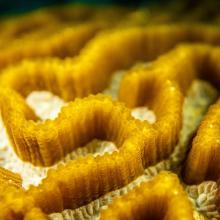Advances in computer animation and simulation, high dynamic range 3D displays, and text-art design tools are being presented by UBC researchers at the world's largest computer graphics conference, being held in Vancouver this week.
Among the technology and findings being presented by UBC computer scientists at SIGGRAPH 2011 at the Vancouver Convention Centre, August 7 to 11:
Creating rich, readable text-art with a computer
Alla Sheffer, UBC associate professor of Computer Science and her team is unveiling a computerized digital design tool that combines images with readable, meaningful text--micrograms. Traditional micrograms are created by highly skilled artists and involve a huge amount of tedious manual work. The tool automatically generates readable micrograms starting from a vector image and text while providing a variety of optional high-level controls to the user. The system was created in collaboration with researchers from the Israel Interdisciplinary Centre and Adobe.
Examples of Sheffer's micrograms are available for download.
Real-time, interactive simulation is for the dogs
Michiel van de Panne, UBC professor of Computer Science and his team is revealing a physics-based simulation that mimics a variety of canine motions, from walking, pacing and trotting to jumping and leaping over obstacles. Using dual leg frame and flexible spine models, the real-time simulation tool is being used to develop life-like canine characters for games, film and simulations, in collaboration with Disney Research Zurich and researchers from Grenoble University. Van de Panne holds the Canada Research Chair in Computer Graphics and Animation.
A YouTube video of the simulation is available online.
A better way to produce high-resolution simulations of flowing liquids
Art direction of high resolution and natural-looking liquid simulations is notoriously hard, due to both the chaotic nature of the physics and the computational resources required. Robert Bridson, an expert on physics-based animation and simulation and associate professor at UBC, is presenting a method of constraining or guiding a high resolution liquid simulation to stay close to a finalized low resolution version. The method is generally faster than an unconstrained simulation and can be integrated with a standard fluid simulator.
Toward higher-resolution 3D displays with greater depth of field
Wolfgang Heidrich, UBC professor and Dolby Research Chair, is presenting findings that explore displays with more than two depth layers. Created with colleagues from UBC and the MIT Media Lab, the team's tomographic optimization system resolves inconsistencies between views, leading to brighter, higher-resolution 3D displays with extended depth of field and improved dynamic range.
Large-scale dynamic simulation of ropes and cables, better collision simulations
A significant challenge in computer animation is the simulation of ropes, cables and other highly constrained strand-like physical curves--for example, when a strand wraps around rigid bodies or passes through narrow sheaths. Dinesh Pai, UBC professor and Canada Research Chair in Sensorimotor Computation and colleagues are introducing a new framework that generates robust, efficient, and accurate simulations of massively constrained systems of rigid bodies and strands. Pai and UBC’s Sensorimotor Systems Lab are also presenting an algorithm that improves the simulation of viscoelastic solids undergoing large, complex deformations when colliding. The method is effective for simulation of complicated contact scenarios involving multiple highly deformable objects, and can directly simulate volumetric models obtained from medical imaging techniques such as CT and MRI. In collaboration with colleagues in France, Pai's group is presenting two additional papers on efficient deformations that blend animator control and physical simulation.
About SIGGRAPH
The SIGGRAPH conference is a five-day interdisciplinary forum that attracts the world’s leaders in computer graphics and interactive techniques, and is widely considered the field's most prestigious arena for the publication of computer graphics research. The conference provides close-up views of the latest in digital art, emerging technologies, and hands-on opportunities for creative collaboration.
Musqueam First Nation land acknowledegement
We honour xwməθkwəy̓ əm (Musqueam) on whose ancestral, unceded territory UBC Vancouver is situated. UBC Science is committed to building meaningful relationships with Indigenous peoples so we can advance Reconciliation and ensure traditional ways of knowing enrich our teaching and research.
Learn more: Musqueam First Nation
Faculty of Science
Office of the Dean, Earth Sciences Building2178–2207 Main Mall
Vancouver, BC Canada
V6T 1Z4


